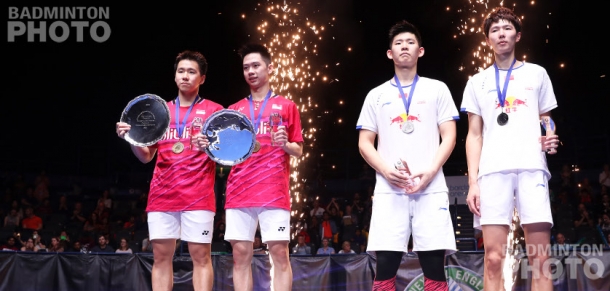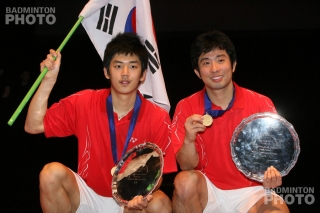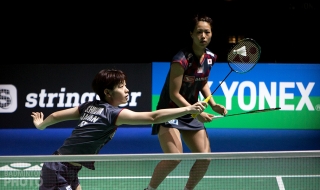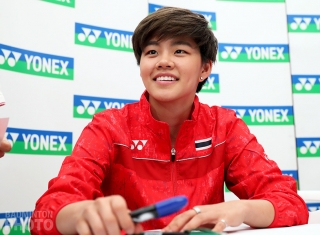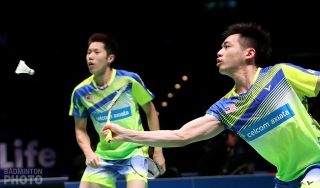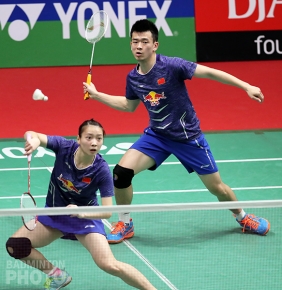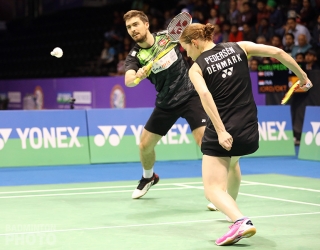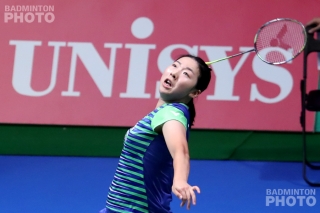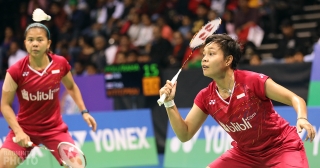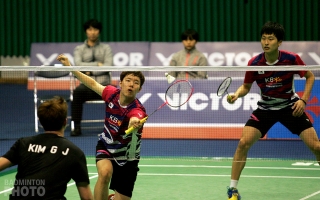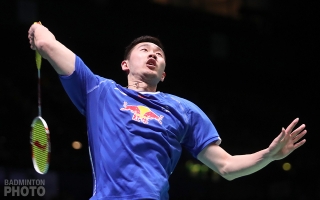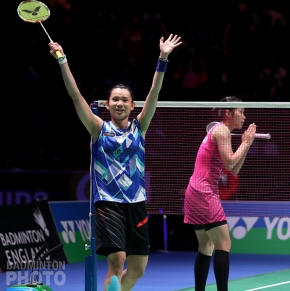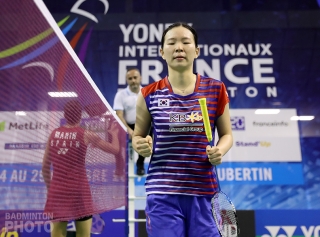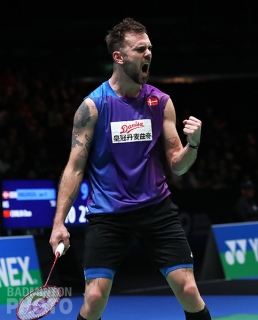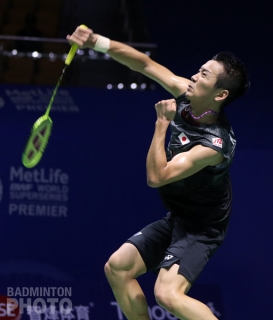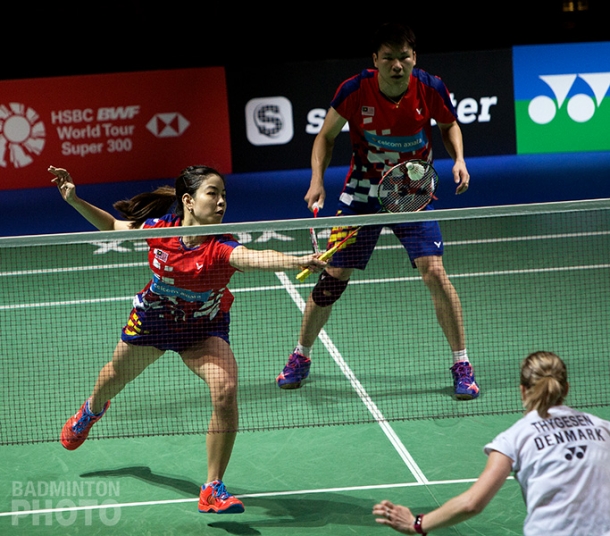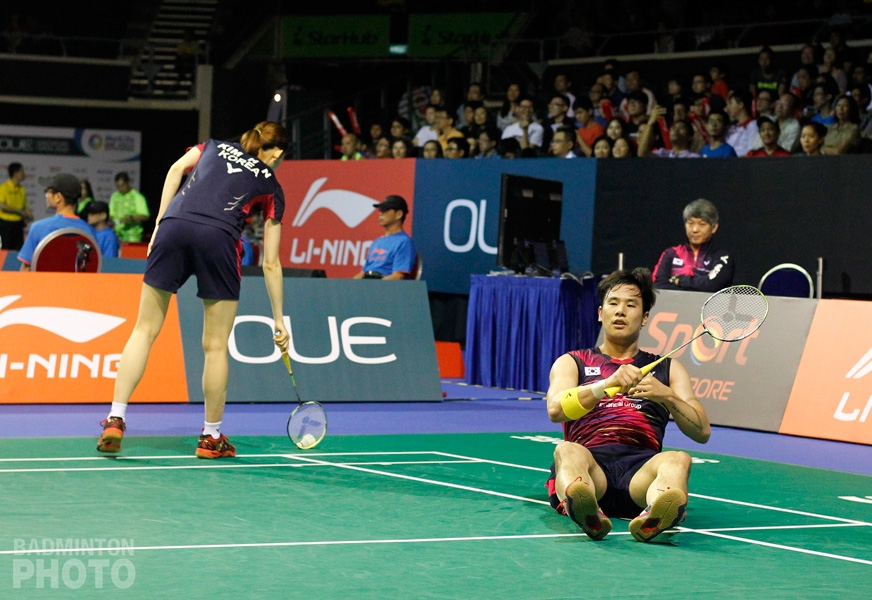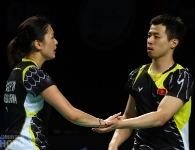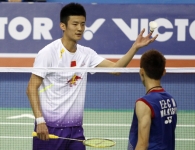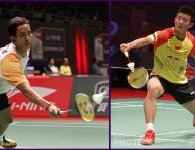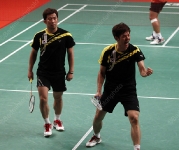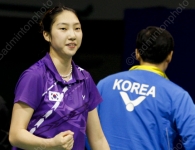It’s early in the year so we ought not to over interpret the meaningfulness of the upcoming All England results, cautions our preview specialist, Aaron Wong.
Photos: Badmintonphoto
Who else wants to be a millionaire?
Following three US$150k and three US$350k events of the newly rebranded BWF World Tour, the All England Championships suddenly ramps up the sporting season’s early prize money stakes to a million dollars befitting its newly minted ‘Super 1000’ status. This makes it the second richest country specific tournament this year, along with the China Open – a position both are taking over from 2017’s Australian Open Superseries and Denmark Open Superseries Premier.
Long known as the most prestigious annual competition, it has also been a long time coming for the All England to offer attractive spoils to match. At the advent of the Superseries, players shared US$200k, bringing the All England up from 2006, when it was barely in the top 10 in prize money. During its Superseries Premier debut in 2011, its position was equal fourth but a staggering $850k behind the biggest payer, while come the final year of the Superseries era its winnings remained in the same position but at a more apt US$600k.
Other million-dollar or greater badminton tournaments are or have been the Superseries Finals, Korea Open, Indonesia Open and – coming this year – the China Open and World Tour Finals.
Hello Thomas
With the Thomas and Uber Cups (TUC) due at the end of May, it is not a big deal not to peak yet for the players from countries likely to be contesting its semi-finals. For them, the TUC is the higher priority so don’t despair and lament the best days being past for your favourite player if he or she happens to fail to take the title in Birmingham.
However, these players will want to be surveying how much they are “getting there”. Going in with a relaxed rather than ‘Olympic’ attitude can only be beneficial when it comes to getting a true measure of one’s current optimum level.
We’ve missed you
The All England welcomes the re-emergence of a bunch of top 10 players who had suddenly dropped out of sight for months, many of whom left a vacuum in mixed doubles.
China’s Sun Yu hasn’t competed internationally since the World Championships back in August. Joachim Fischer Nielsen broke his left ankle at that Glasgow event and restarted last week with new partner Alexandra Bøje. Birmingham is their second outing. Similarly, Sapsiree Taerattanachai (pictured) also embarks on a second mixed tournament since shoulder injury at the SEA Games sidelined her for the rest of 2017.
Rio Olympic silver medallist Goh Liu Ying in mixed as well as former men’s singles world #2 Jan Jorgensen missed the most months last year, hence their world rankings plummeted whereas the others still hover within the top 20.
Reunited
Fans are thrilled with unexpected reformations of pairings feared to have disbanded for good. Li Yinhui and Zhang Nan rekindle their mixed partnership, as do Debby Susanto / Praveen Jordan.
On the men’s side, twice former men’s doubles World Champions, Hendra Setiawan / Mohammad Ahsan are a team once more as are Malaysia’s other Rio silver medallists Goh V Shem / Tan Wee Kiong (pictured) and the pair they temporarily shuffled amongst, Teo Ee Yi / Ong Yew Sin.
Fans only realised how much they missed these stars or famed duos once their magic was gone. In terms of competition and results, doubles reshuffling appears to activate quickly as a temporary surprise package in team events, in the women’s level event or Indonesian men’s doubles. The rest have to work at it, with the amazing exception of Huang Yaqiong / Zheng Siwei (pictured right), who found success from the get go.
Mixed doubles: Favourites Huang Yaqiong / Zheng Siwei
Last year Badzine lamented that Malaysia’s Shevon Jemie Lai / Goh Soon Huat (pictured bottom) weren’t receiving enough exposure. Now that they are the newly crowned German Open champions are travelling from strength to strength.
So many unheralded mixed pairs made breakthroughs in the past year that the Malaysians have as much of a chance as the next person of going far in the draw until one of them meets the pair to beat who are China’s fifth seeds Huang Yaqiong / Zheng Siwei.
Huang/Zheng’s impressive credentials are four wins out of five finals in five events they’ve entered. The sixth seeds Christinna Pedersen / Mathias Christiansen (pictured left) probably stand the best chance of resisting the Chinese favourites which could take place at the semi-finals.
Top seeded Rio Olympic champions Liliyana Natsir / Tontowi Ahmad have as good a draw as they could possibly hope for by avoiding Huang/Zheng until a final if at all.
Interestingly, quite a few players who normally enter both doubles events have chosen to concentrate on mixed, like Huang/Zheng, their compatriots Huang/Wang, Hong Kong’s Tse/Tang, and Thailand’s Sapsiree Taerattanachai.
Early matches of note:
Huang Dongping / Wang Yilyu (CHN) [2] vs. Chae Yujung / Choi Solgyu (KOR)
Tse Ying Suet / Tang Chun Man (HKG) [3] vs. Arisa Higashino / Yuta Watanabe (JPN)
Gabrielle Adcock / Chris Adcock (ENG) [7] vs. Shevon Jemie Lai / Goh Soon Huat (MAS)
Chau Hoi Wah / Lee Chun Hei (HKG) vs. Sapsiree Taerattanachai / Dechapol Puavaranukroh (THA)
Women’s doubles: Japanese and Korean density
Reshuffling the Korean deck and reshuffling back worked a treat for Lee So Hee / Shin Seung Chan but not so for Chang Ye Na and Jung Kyung Eun. Good that their coach wasted little time in shuffling again, given the Uber Cup on the horizon.
Kong Hee Yong (pictured left) is a player to circle — and one wonders whether Kong/Chang could turn out in future to be a winning combination. For the moment, playing as many different opponents as possible is the exposure therapy needed to help her judgement settle; her excellent baseline skills are not in question.
As a pair, Indonesian sixth seeds Greysia Polii and Apriyani Rahayu (pictured) continue to impress. Rahayu is a vital source of good rhythm for her partner who loves to scheme. After all, thoughtful doubles players need time and space to think to produce their best work.
A contrast that’s hard to miss at this All England is that Korea have fielded four women’s pairs, Japan five, and China just the one. So by the semis it could potentially be only Korea and Japan left. Top seeds and current World Champions Chen Qingchen / Jia Yifan have three Japanese pairs in their top half of the draw which seems ominous for their chances to title as Jia can be made to tire out.
Early matches of note:
Misaki Matsutomo / Ayaka Takahashi (JPN) [2] vs. Ashwini Ponappa / Reddy N. Sikki (IND)
Kamilla Rytter Juhl / Christinna Pedersen (DEN) [3] vs. Setyana Mapasa / Gronya Somerville (AUS)
Della Destiara Haris / Rizki Amelia Pradipta (INA) vs Chang Ye Na / Kim Hye Rin (KOR)
Men’s doubles: World Champs and Olympic silvers meet predecessors
There are excellent and interesting first round men’s doubles matches everywhere you look. Too many. It’s an indication that the level playing field is broadening.
Both Korean pairs – veterans Chung Eui Seok / Kim Duk Young and youngsters Kim Won Ho / Seo Seung Jae (pictured left) – are unknown quantities as there’s a lot of maturing in the dynamics of the partnerships still to go. What we know is because they are highly trained, they neither shrink from a challenge nor easily fall prey to nerves or lapses in concentration which is a good foundation to build on. However, does this make them predictable to read for experienced opponents? That’s the angle from which to judge their next stage of progress.
The Koreans face the second and third seeds respectively in their opening rounds. Similar to Kong Hee Yong’s case, such exposure therapy couldn’t be more beneficial for them right now. Thereafter their ascension could happen quickly as familiarity with that opponent might be all they lacked.
For the three very different Taiwanese pairs, their requirements for progress are bespoke. It is certain opponents each is fundamentally troubled by and that’s the problem each needs to solve. For Chen Hung Ling / Wang Chi-Lin, they are yet to get the measure of world #1 Marcus Fernaldi Gideon / Kevin Sanjaya Sukamuljo.
Who could be the defending champions Gideon/Sukamuljo final’s opponents? Quite likely the current World Champions Zhang Nan and Liu Cheng (pictured right). The bottom half of the draw is salivating at the prospect of delicious battles between 2017 and 2015 World Champions as well as 2016 and 2012 Olympic silver medallists. All things being equal, Liu Cheng’s newfound nuanced play since the Worlds shifts the weight slightly in their favour.
Early matches of note:
Li Junhui / Liu Yuchen (CHN) [3] vs. Kim Won Ho / Seo Seung Jae (KOR)
Takeshi Kamura / Keigo Sonoda (JPN) [5] vs. Goh V Shem / Tan Wee Kiong (MAS)
Lee Jhe-Huei / Lee Yang (TPE) [8] vs. Vladimir Ivanov / Ivan Sozonov (RUS)
Fajar Alfian / Muhammad Rian Ardianto (INA) vs. Ong Yew Sin / Teo Ee Yi (MAS)
Women’s singles: Great rivalries at quarters and semis
Although both singles disciplines presently share a basic premise that most within the top 15 are capable of eliminating the other, women’s singles does contain a subset of seven whom reliably inflict carnage more of the time including on their own ‘kind’.
Hence, one could be dealt the unfortunate draw that is a gauntlet made up mainly of these seven. Mark I of this scenario used to be finding only Chinese players in your path (and Malaysia’s Wong Mew Choo and Denmark’s Camilla Martin before her famously pushed past these gladiators). You could say the gauntlet’s level of difficulty now is trickier because there are various styles to counter.
Bearing this in mind, Saina Nehwal and Chen Yufei have drawn the short straws by being in the same half of the draw as both of last year’s finalists Tai Tzu Ying and Ratchanok Intanon (pictured left).
Nehwal possesses maturity and pragmatism, which is also to say she embraces the problem she finds difficult to solve. She took umpteen attempts before clearing Wang Yihan, and the Tai Tzu Ying hurdle is no different.
The great contemporary rivalries are in line to occur before the final, which is good news for earlier ticketholders. Tai and Intanon will clash at the semi-final stage, if they both advance, while Nozomi Okuhara and P.V. Sindhu book a date at the quarters.
Zhang Beiwen proved something to herself in grabbing her India Open major. The next player it would be nice to see breakthrough is Nitchaon Jindapol but the All England draw hasn’t been kind. Jindapol potentially has to surmount Zhang, followed by Sindhu and Okuhara, and there’s no relenting after. Two talented outsiders, Lee Jang Mi (pictured) of Korea and Japan’s Saena Kawakami, await Rio Olympic champion Carolina Marin. Relatively speaking, the Spaniard has the best path towards the semis for a seeded player because her possible clash with the ever hardy Yamaguchi is not one of the great rivalries. That said, Yamaguchi is warmed up from picking up her first title of 2018 at the German Open and she reached the finals of five Superseries last year.
Early matches of note:
Tai Tzu Ying (TPE) [1] vs. Saina Nehwal (IND)
Ratchanok Intanon (THA) [3] vs. Michelle Li (CAN)
Carolina Marin (ESP) [5] vs. Lee Jang Mi (KOR)
He Bingjiao (CHN) vs. Goh Jin Wei (MAS)
Zhang Beiwen (USA) vs. Nitchaon Jindapol (THA)
Men’s singles: Former #2 vs current #2 at Round 2
So, the ‘bad’ news first. World #1 and World Champion Viktor Axelsen hasn’t sufficiently recovered from surgery and withdrew, and any Lee-Lin rendezvous would be a Thursday quarter-final.
This high profile match as well as title defence going ahead may well hinge on what sort of quality and surprises the rejuvenated former world #2 Jan Jorgensen (pictured left) has in store for current #2 Lee Chong Wei at Round 2. Lee had been uncharacteristically vulnerable in early rounds in 2017 so that’s something to keep surveying in the short term.
The top half of the draw is characterised by a preponderance of defensive players and vice versa in the bottom half. Srikanth Kidambi against Anthony Ginting is another quarter-final worth watching for abundant finesse on both sides, and whether the younger Indonesian possesses the kind of tricky to calibrate patience required against an opponent exemplary at both defense and attack.
The overall condition of the Indian singles contingent will be monitored by other country’s coaches for Thomas Cup purposes. India has reached the point of sufficient breadth and depth but can it replicate this while under extra pressure to cover for their weaker doubles side during the team event?
The player development to follow is that of Kenta Nishimoto (pictured right). At a glance, nothing appears dramatically different but his cluster of good scorelines after the middle of 2017 suggest otherwise. He is breaking out of the Takuma Ueda mold. Japanese players are reliably sturdy but Nishimoto is beginning to add layers on top of this. His higher than Japanese-average concentration seems borne of a quiet yet soulful temperament.
Early matches of note:
Lin Dan (CHN) [6] vs. Hans-Kristian Vittinghus (DEN)
Shi Yuqi (CHN) [7] vs. Jeon Hyeok Jin (KOR)
Chou Tien Chen (TPE) [8] vs. H.S. Prannoy (IND)
Wong Wing Ki (HKG) vs. Jonatan Christie (INA)
For Part I of the All England preview, click here
![ALL ENGLAND 2018 Preview Part II – Average 200 to Super 1000 in 11 years It’s early in the year so we ought not to over interpret the meaningfulness of the upcoming All England results, cautions our preview specialist, Aaron Wong. Photos: Badmintonphoto Who else […]](http://www.badzine.net/wp-content/uploads/ngg_featured/20170312_1651_AllEngland2017_BPYN2682_rotator.jpg)
